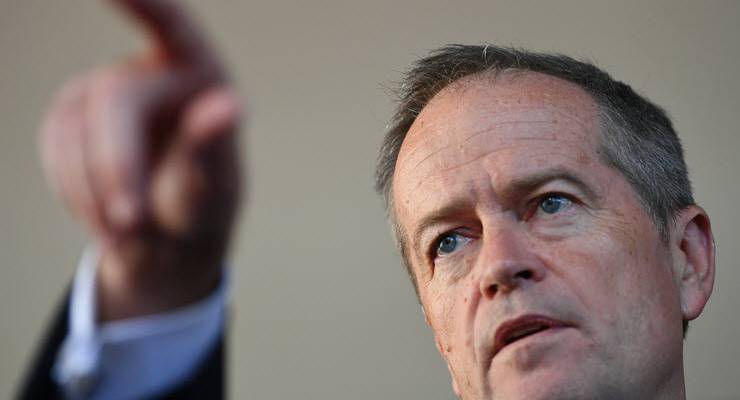
When Labor announced its energy package roughly six months ahead of the election, accusations of cynicism and surrender abounded.
Labor, critics said, had sold out. Instead of committing to its proposed 2016 emissions trading scheme, it just revamped Malcolm Turnbull’s National Energy Guarantee. But the accusations were offset by relief that something, anything might be done to fill Australia’s policy vacuum — even if that meant circumventing parliament with $15 billion of direct action.
It was no Clean Energy Act 2011, but a NEG aimed at 45% emissions reduction on 2005 levels by 2030, a $10 billion top-up of the Clean Energy Finance Corporation (CEFC), $5 billion into transmissions infrastructure, plus battery, electric car and worker transition packages sure sounded better than the Coalition’s plan for “nothing”, “soil magic”, and a power project that shortlisted a party donor-owned coal plant.
But after a roller coaster of a decade, and setting aside the recently announced emissions trading scheme (ETS) for non-energy sectors, what chance is there of Bill Shorten stabilising the grid? Crikey looks at the multiple different ways Labor’s “art of the possible” scheme could go down.
What’s the strategy?
Key to Bill Shorten’s announcement of a revamped NEG was that, with a planned $15 billion, 10-year injection into renewables, grid and storage infrastructure, Labor would “work with the Coalition — but we will not wait for them”.
The reasons for foregrounding bipartisanship are both short- and long-term politics: take the high ground with a party that couldn’t agree on its own policy, while knowing that, without the CEFC acting as a buffer, any investment certainty gained by legislation passed with the crossbench is weakened by the prospect of a future Coalition government pulling a Tony Abbott.
But in the very unlikely event that the Liberal or National parties reject an energy policy, a future Shorten government would either have to bite the bullet and work with the crossbench, or continue on with the policy vacuum and hope the $15 billion investment package fills the void.
When asked about which is more likely, a spokesperson for Mark Butler, Labor’s energy spokesperson, would only reiterate that “bipartisanship is the best way the NEG can provide the investor certainty that’s needed to transition to a modern electricity system”.
A recent history of Australia’s energy investment
The CEFC launched in 2012 with Gillard’s carbon price, a Renewable Energy Target of 41,000 GWh, and a mandate to deliver a return on $10 billion worth of investments in renewables and low-emission projects. In that time it has invested the following in relation to major political changes:
- 2012-13: $135.8 million — Clean Energy Act commences July 1.
- 2013-14: $795.2 million — Abbott becomes PM September 18, threatens CEFC and RET.
- 2014-15: $484 million — carbon price repealed July 1, 2014.
- 2015-16: $837 million — RET reduced to 33,000 GWh June 23; Turnbull becomes PM September 15.
- 2016-17: $2.1 billion — Hazelwood announces closure November 3, closes March 27, removing 12,000 GWh from the National Electricity Market.
- 2017-18: $2.3 billion — RET still in place.
- 2018-19 (projected): $530 million — decrease due to Renewable Energy Target officially being met by end of 2018.
That 2014-15 dip can be traced to Abbott threatening both the CEFC, which again has to return to taxpayer funds, and investment certainty in general — Bloomberg Energy Finance’s reports that overall investment across the financial year fell to $3.17 billion, or 31% on the previous financial year.
While Turnbull attempted to weaken the CEFC with a carbon capture and storage thought-bubble and pork barrelling Great Barrier Reef-linked solar projects, he at least kept the body alive. Green Energy Markets’ director of analysis and advisory Tristan Edis believes it wasn’t until Turnbull announced the body would remain funded and Hazelwood power station shut in 2017, “which then lifted prices considerably, that you saw the floodgates open for renewable energy projects”.
2019 is obviously a very different investment scenario to 2014: renewables are the cheapest form of new power and firming technologies are poised for a similar price decline. A spokesperson for the Australian Energy Market Operator (AEMO) tells Crikey that, according to last year’s transition outlook, the Integrated System Plan (ISP), the two greatest influences on power system development are no longer solely driven by policy: firstly, changes in the timing for retiring old coal-fired generation, and secondly, the rate of new investment in renewable generation.
That ISP also informs Labor’s proposed $5 billion Energy Modernisation Fund, which will allocate both loans and equity for grid upgrades and technologies, while the household battery scheme and even electric car targets offer benefits to an increasingly distributed energy system.
What do the experts say?
Director of the Victoria Energy Policy Centre Bruce Mountain maintains that the entire $15 billion-plus package is far preferable operating without the NEG. He argues that tender and auction mechanisms adopted by the CEFC, and the Victoria and ACT governments, have been pro-market. Indeed, they “have been shown to deliver vigorous competition amongst competing developers, to the benefit of the environment and consumers”.
But the RET has been officially met, the only Coalition policy is an ad-hoc underwriting program, and the next major plant retirement — AGL’s hotly contested Liddell station — is still three years away. So the prospect of another policy vacuum looms, threatening investment confidence. This is why major retail generators like AGL, Origin ($) and EnergyAustralia have all publicly voiced support for emissions trading of some kind.
EnergyAustralia executive Mark Collette agrees that much of the current investment is largely off the back of the Renewable Energy Target — “it’s the one area in energy which has had long-term, bipartisan support” — and, perhaps unsurprisingly, favours the NEG over direct intervention.
“Labor’s alternative policies rely more on taxpayer-funded initiatives and direct interventions,” Collette said. “We don’t think that is the preferred way to go, the best answer is a market where governments provide a policy framework that galvanises investment without requiring direct support.”
Edis believes that both direct action and a revamped NEG are necessary. The CEFC’s longevity, he argues, would be required to bolster any NEG the Coalition threatens to eventually dismantle in that it could at least enable short-term investment by behaving “on the basis as if this thing is permanent, and [they] will help underwrite new capacity to help deliver on this emission reduction target set in the NEG”.
Alternatively, the prospect of funding the CEFC without a change in its direction risks repeating the Abbott years.
Regardless of Coalition support, he urges a potential Shorten government to both pass a more efficient version of the NEG with the crossbench and, rather than targeting the National Energy Market through a COAG process requiring state government support, create federal legislation covering retailers, including those outside the NEM: Western Australia and the Northern Territory.
“Without changing the CEFC Act, and without managing to pass some kind of NEG-like policy, my worry is that the CEFC board may not feel it has the freedom to underwrite significant amounts of new renewables capacity because there is a reasonable risk power prices are pushed down too low for them to recoup their money,” said Edis.
Finally, given energy generation is Australia’s most polluting and “flexible” sector, multiple energy experts argue that Labor’s 45% reduction target electricity is largely inadequate. Citing advice by ClimateWorks, Climate Council solutions researcher Louis Brailsford tells Crikey that, “in order for Australia to do its fair share in addressing climate change, the electricity sector should be reducing its emissions by at least 60% by 2030”.
This is to say nothing of the Greens’ 100% renewable target, proposed publicly owned renewables retailer, or plan to phase out Australia’s largest contributor to climate change, fossil fuel exports — which not only does Labor not plan to limit but, as of April, plans to bolster with a $1.5 billion pipeline fund aimed at ripping up northern Australia gas fields.
But at least for domestic energy policy, and for a fifth-rate, overly complicated and still opaque policy, Labor’s revamped NEG could in fact prove better than nothing.








It’s a start.
“A journey of a thousand miles begins with a single step.”
According to Bernard a few weeks ago the 250 companies doing the reductions can shift their baselines if it gets too hard to meet targets, potentially rendering the scheme ineffective. Seems like some tougher rules are required.
Yeah Scooter, there’s far to much green tape in the wide “brown” land. Not long after Glen Turner NSW Environment Officer was tormented for half an hour and then shot in the back, murdered by a serial illegal land clearer at Croppa Creek in NSW in 2014, vegetation clearing laws were relaxed by the LNP in NSW. The Hon B Joyce showed his usual decency by blaming Turner and the veg laws. What a bunch of moral bankrupts.
In my fury using a small screen I’ve posted this in the wrong comment section. Should be in BK’s piece on Green Tape. Apologies.
Yes the relaxation of the land clearing laws has created so many problems..
We need to remember it isn’t just carbon emissions & capture that the trees exist to do & need to be protected from the greedy land clearance people, (who claim to do it as there are no other jobs) they are home to a large range of native species, (which are creeping ever closer to extinction), they help bring rain to our country, which happens to be one of the driest continents in the world & as far as I can tell it’s getting drier, the LNP want to give this precious resource to cotton, rice farmers & Adani for $0, (but our farmer aren’t worth going into bat for though)..
The LNP government has failed miserably, in protecting the land & the native species that are a large part of the eco biodiversity..
It’s time for a whole revamp of environmental & Energy policy/developments, how the Federal govt will actually deal with Energy & it’s production, could be their downfall, or the states will note their inaction & just fund projects themselves, (SA has taken the lead on this) which will again show the Federal governance & govt are generally grinding to a standstill in regards to these issues & the State govt’s will ask for the funding to cover these developmental costs & the Federal govt will again be left wrong footed.
To me this just highlights that we have way too many layers of government & it’s time for a reduction in these layers that invariably replicate each other & cost the tax payer’s far too much..
I think we should hold off for another 6 years of Liberal “Government” until the ALP come up with a perfect scheme or the Greens win power. Which ever comes first.